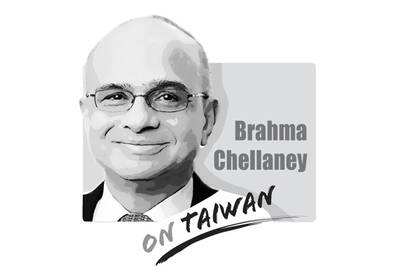Wansui (萬歲, “long live,” literally “10,000 years old”) is the most feudal, hypocritical and cheap phrase. No state, government or dynasty exists for 10,000 years.
Still, members of the postwar generation that received party-state-dictated education share a deeply felt memory of chanting “long live the Republic of China (ROC)” together with Chiang Kai-shek (蔣介石) and cheering “long live President Chiang,” despite not understanding his Ningbo dialect of Mandarin Chinese.
Many years have passed since Chiang died in 1975. In China’s history books, the ROC existed for 38 years, one year longer than the Sui Dynasty (隋朝), (581-618) and not even comparable to the Qing (清朝), (1644-1911) that Sun Yat-sen (孫逸仙) wanted to expel and that ruled for 267 years, or the Yuan (元朝), (1279-1368), which ruled for 97 years.
Unbelievably, even after Taiwan’s democratization, some people still chant the decades-old slogan “long live the ROC,” using it as their political platform.
For the Chinese Nationalist Party (KMT), a foreign party that never acclimatized itself to Taiwan, the habit of using this cheap slogan is so ingrained that its presidential candidate, Kaohsiung Mayor Han Kuo-yu (韓國瑜), says he does not want votes from people who support Taiwanese independence.
Han’s statement may make him sound strong, but it is misdirected. When Han was just two years old, Chiang signed a joint communique with the US, in which he renounced the use of force to “reconquer the mainland.” That was when Chiang’s version of Taiwanese independence started.
At the time, Chiang emphasized that he was China’s legitimate ruler and said it was his sacred mission to “reconquer the mainland and liberate and rescue fellow compatriots.” Then-US secretary of state John Foster Dulles made it plain to Chiang that he did not have to renounce the “mission,” but should not try to accomplish it by force.
Without US military support, Chiang lacked the strength to retake China, and the US made it clear that it would not use its armed forces to help him at the risk of starting a war.
To maintain the facade, Chiang could not publicly renounce the use of force, so he resorted to vague language, stating: “The task of recovering the mainland will be accomplished by 70 percent political and 30 percent military effort.” He also said he would not return to China unless a revolution broke out and a new regime invited the KMT government back.
After Chiang died, his son Chiang Ching-kuo (蔣經國) was determined to protect Taiwan, so he proposed the “three noes” policy of no contact, no compromise and no negotiation to avoid surrender. From this point, the ROC title became a fig leaf for the exiled KMT government’s monopoly on power and its refusal to democratize, but Taiwan’s eventual democratization ended this charade.
The definition of “Taiwanese independence” is ambiguous, but everyone knows that it means to “refuse unification.” If the phony politicians who chant “long live the ROC” had real backbone, they would say: “I don’t want those who oppose Taiwan’s annexation by China to vote for me, I only want the votes of those who want unification.”
James Wang is a senior journalist.
Translated by Chang Ho-ming

China badly misread Japan. It sought to intimidate Tokyo into silence on Taiwan. Instead, it has achieved the opposite by hardening Japanese resolve. By trying to bludgeon a major power like Japan into accepting its “red lines” — above all on Taiwan — China laid bare the raw coercive logic of compellence now driving its foreign policy toward Asian states. From the Taiwan Strait and the East and South China Seas to the Himalayan frontier, Beijing has increasingly relied on economic warfare, diplomatic intimidation and military pressure to bend neighbors to its will. Confident in its growing power, China appeared to believe
Taiwan-India relations appear to have been put on the back burner this year, including on Taiwan’s side. Geopolitical pressures have compelled both countries to recalibrate their priorities, even as their core security challenges remain unchanged. However, what is striking is the visible decline in the attention India once received from Taiwan. The absence of the annual Diwali celebrations for the Indian community and the lack of a commemoration marking the 30-year anniversary of the representative offices, the India Taipei Association and the Taipei Economic and Cultural Center, speak volumes and raise serious questions about whether Taiwan still has a coherent India
Recent media reports have again warned that traditional Chinese medicine pharmacies are disappearing and might vanish altogether within the next 15 years. Yet viewed through the broader lens of social and economic change, the rise and fall — or transformation — of industries is rarely the result of a single factor, nor is it inherently negative. Taiwan itself offers a clear parallel. Once renowned globally for manufacturing, it is now best known for its high-tech industries. Along the way, some businesses successfully transformed, while others disappeared. These shifts, painful as they might be for those directly affected, have not necessarily harmed society
Legislators of the opposition parties, consisting of the Chinese Nationalist Party (KMT) and the Taiwan People’s Party (TPP), on Friday moved to initiate impeachment proceedings against President William Lai (賴清德). They accused Lai of undermining the nation’s constitutional order and democracy. For anyone who has been paying attention to the actions of the KMT and the TPP in the legislature since they gained a combined majority in February last year, pushing through constitutionally dubious legislation, defunding the Control Yuan and ensuring that the Constitutional Court is unable to operate properly, such an accusation borders the absurd. That they are basing this